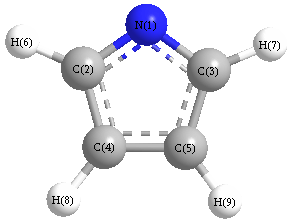Vibrational Frequencies calculated at MP2/CEP-31G*
| Mode Number |
Symmetry |
Frequency
(cm-1) |
Scaled Frequency
(cm-1) |
IR Intensities
(km mol-1) |
Raman Act
(Å4/u) |
Dep P |
Dep U |
|---|
| 1 |
A1 |
3289 |
3122 |
0.90 |
|
|
|
| 2 |
A1 |
3256 |
3091 |
0.85 |
|
|
|
| 3 |
A1 |
1583 |
1503 |
22.72 |
|
|
|
| 4 |
A1 |
1471 |
1397 |
30.64 |
|
|
|
| 5 |
A1 |
1252 |
1189 |
14.59 |
|
|
|
| 6 |
A1 |
1112 |
1056 |
40.84 |
|
|
|
| 7 |
A1 |
1072 |
1018 |
9.67 |
|
|
|
| 8 |
A1 |
875 |
831 |
9.65 |
|
|
|
| 9 |
A2 |
904 |
858 |
0.00 |
|
|
|
| 10 |
A2 |
861 |
817 |
0.00 |
|
|
|
| 11 |
A2 |
511 |
486 |
0.00 |
|
|
|
| 12 |
B1 |
893 |
848 |
0.41 |
|
|
|
| 13 |
B1 |
740 |
702 |
106.76 |
|
|
|
| 14 |
B1 |
569 |
540 |
31.07 |
|
|
|
| 15 |
B2 |
19535 |
18546 |
0.00 |
|
|
|
| 16 |
B2 |
3260 |
3095 |
104.21 |
|
|
|
| 17 |
B2 |
3242 |
3078 |
57.14 |
|
|
|
| 18 |
B2 |
1315 |
1249 |
139.19 |
|
|
|
| 19 |
B2 |
1290 |
1224 |
15.20 |
|
|
|
| 20 |
B2 |
1024 |
973 |
0.12 |
|
|
|
| 21 |
B2 |
875 |
830 |
4.75 |
|
|
|
Unscaled Zero Point Vibrational Energy (zpe) 24464.8 cm
-1
Scaled (by 0.9494) Zero Point Vibrational Energy (zpe) 23226.8 cm
-1
See section
III.C.1 List or set vibrational scaling factors
to change the scale factors used here.
See section
III.C.2
Calculate a vibrational scaling factor for a given set of molecules
to determine the least squares best scaling factor.
